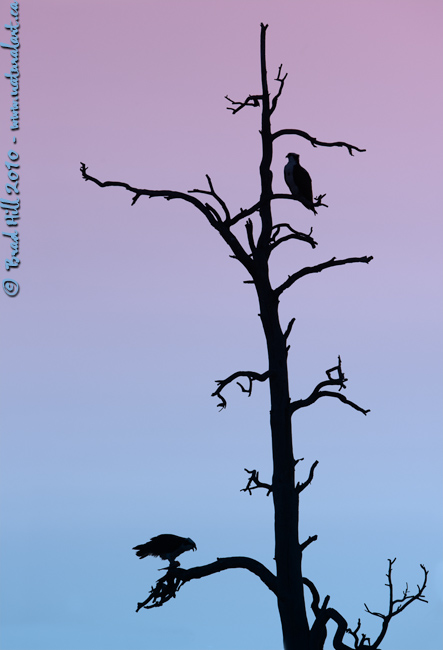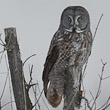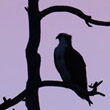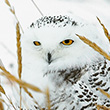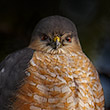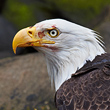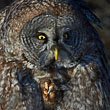Availability: Undetermined - Enquiries?
In the Field
The Osprey Tree. Findlay Creek, BC, Canada. April 21, 2010.
Consider this image as proof that Osprey do NOT hatch from eggs like normal birds - the actually come from (or should I say "bloom"?) from rare and elusive trees found only in remote mountain valleys! ;-)
This long-dead ponderosa pine sits near a large Osprey nest that is active each year. It's located not far from my cabin and I always check it out if I'm passing by it. On this spring morning I happened to be going by it with a full load of camera gear (including both my 600mm f4 VR and my 400mm VR and 1.4x and 2x tele-converters) so I was well equipped to grab some images in the beautiful pre-sunrise light.
The first thing that struck me about the scene was how much it looked like a painting, even to the naked eye. In particular, it reminded me of the work of Henry Vickers - a prominent Canadian aboriginal painter whose work I quite like. The mountains behind the tree were in the distance, so I knew that the final image would look even MORE painterly if I chose a long telephoto lens (to render the background completely out-of-focus).
In a sense this wasn't a technically challenging shot to capture. I exposed for the background to intentionally turn the tree and birds into a silhouette. I suppose the toughest aspect of getting the shot was the long wait until both subjects had their head turned and tilted in a way where both showed their beaks simultaneously (which I thought was critical "little thing" needed to make the image work). And, I suppose, I had to BE THERE at the right time - I've passed this tree hundreds of time and so far this is the ONLY time the light and everything else were "just right." What's that saying? Oh yeah..."f8 and BE THERE" (and this image WAS shot at f8!).
NOTE: Both the pink (the sky) and the blue (out-of-focus shaded mountains) were in the original scene. I did enhance the blue (along a gradient), but the pink is all natural!
Behind the Camera
The Osprey Tree. Findlay Creek, BC, Canada. April 21, 2010.
Digital Capture; RAW 14-bit format; ISO 200.
Nikon D3s with Nikkor 600mm f4 VR lens - supported on tripod with Gitzo 1348 tripod with a Wimberley head. VR on and set to "Normal" mode.
1/640s @ f8; +0.33 stop compensation from matrix-metered exposure setting of camera.
At the Computer
The Osprey Tree. Findlay Creek, BC, Canada. April 21, 2010.
RAW Conversion to 16-bit TIFF, including first-pass/capture sharpening using Phase One's Capture One Pro 5. RAW conversion at exposure setting of -0.7 stops to render lighter plumage of birds dark (to appear as a silhouette) and to bring out colour in background.
Further digital corrections on 16-bit TIFF file using Adobe's Photoshop CS4. Photoshop adjustments included selective saturation of colours (blue along a gradient fading out at near the vertical midpoint of the image) and selective sharpening for web output.
Conservation
The Osprey Tree. Findlay Creek, BC, Canada. April 21, 2010.
Ten percent of the revenue generated by this image will be donated to Wildsight.
Species Status in Canada*: This species is not designated as at risk.
The Osprey (Pandion haliaetus) is a diurnal raptor which has a worldwide distribution (except Antarctica) and specializes on eating fish. Osprey hunt by flying high over bodies of water (including fast-moving rivers) and visually searching for their prey. When they locate it, they dive almost vertically and dramatically plunge talons-first into the water. In the 1950's worldwide populations of Ospreys declined, in some cases dramatically. Since then the Osprey has made a comeback - partly because of a reduction in the use of DDT and partly due to reintroduction efforts by concerned groups.
This Osprey was photographed was photographed in the Columbia Valley of the East Kootenays. While Osprey are not considered at threat, many ecosystems within the Columbia Valley face development pressure. Wildsight is an effective conservation organization that protects biodiversity and promotes sustainable communities in Canada's Columbia and Rocky Mountains. Support for Wildsight, through donation or becoming a member, will help ensure that they remain effective in their efforts to conserve threatened or endangered species and ecosystems.
*as determined by COSEWIC: The Committee on the Status of Endangered Wildlife in Canada













